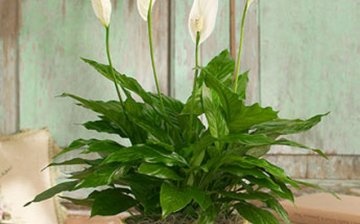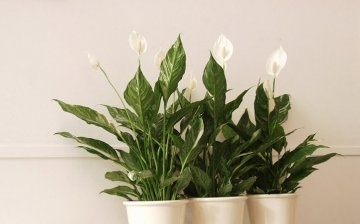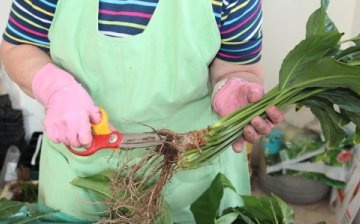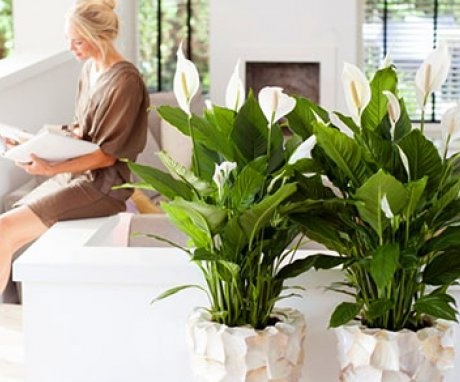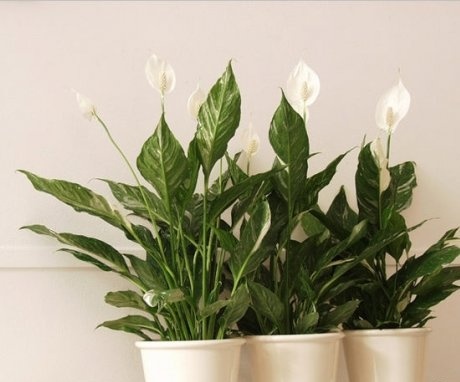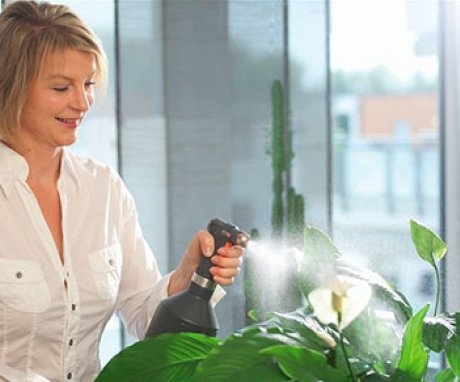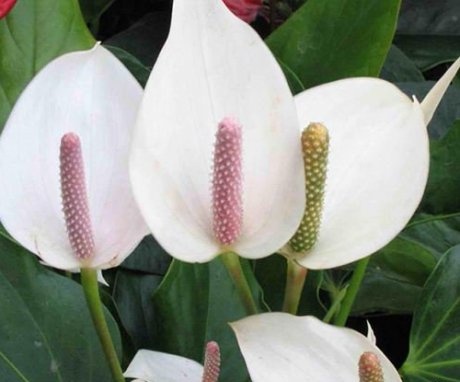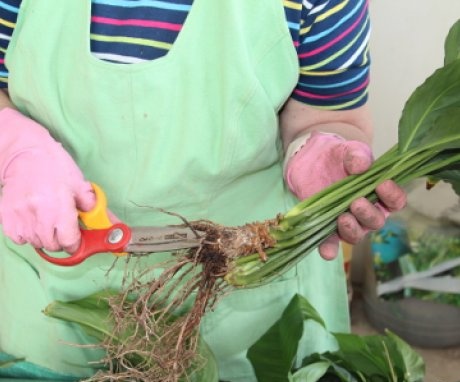Recommendations for flower growers: how to properly care for spathiphyllum
Unusual indoor plants always attract the attention of amateur flower growers. One of them is from Central America - spathiphyllum.
Content:
- Indoor flower description
- Lighting and temperature control
- Watering the plant
- Top dressing of spathiphyllum
- Flower transplant and reproduction
- Diseases and pests - control and prevention
Indoor flower description
A perennial evergreen plant is popularly called female happiness, probably because a delicate white leaf surrounds an ear on a high leg, like a woman surrounds a man with her care and love.
The plant has almost no stem, oblong leaves with a sharp end begin their growth from the rhizome of the flower and look like a lush bunch. The sap of the flower contains poison, so care must be taken that pets do not use the leaves for food.
Whichever variety of indoor plant is chosen, care behind them is the same.
Spathiphyllum has several types:
- In the period from spring to late autumn, the abundantly flowering spathiphyllum pleases the eye. Having a small ear of cream color, it pleases with a green basket of glossy leaves.
- Handsome Wallis from Columbia looks the same, but he was not born in height, only thirty centimeters in height.
- From the forests of Venezuela came the cannoli spathiphyllum, which has a fragrant yellow-green ear, wrapped in a snow-white blanket, and large oval-shaped leaves.
- The flagolite, or adorable variety, has flowers that look like a yellow flag surrounded by white and green surroundings.
- The tallest type of spathiphyllum - spoon-shaped - reaches a meter in height and has a snow-white ear of a flower and the same veil.
Lighting and temperature control
In the early days, when spathiphyllum appears in the house, it likes to stay in the shade, so it is necessary to find a place where the sun's rays will not directly illuminate it.
The flower prefers diffused light or partial shade.
In too dark places, he is uncomfortable, and the leaves from the dark can become narrow and not so lush. The plant is quite thermophilic, but it does not tolerate heat and dry air. It is better to keep it away from heating devices, and in winter time create moisture by covering the batteries with a wet cloth. Also, the flower can die from drafts. The ideal air temperature for him is from 17 to 20 degrees above zero.
The homeland of spathiphyllum is the tropics, respectively, and the environment in the house should be humid, but not too hot.
Watering the plant
The leaves of the plant droop and wilted, which means there is not enough moisture. The appearance of red spots on the green leaves of the indoor flower and the absence flowering - this is a signal that there is an excess of moisture.
To prevent waterlogging of the soil, it is best to pour water into a sump. And to create an imitation of tropical air around the spathiphyllum, wet sand or moss soaked in water is poured there.
The flower loves water treatments in the form spraying, preferably daily, but at least twice a week.
The creation of a humid atmosphere around the tropical beauty will have a positive effect on the state of the leaves, they will become elastic and shiny, and the plant will bloom for a long time.
Top dressing of spathiphyllum
For spathiphyllum, as well as for others indoor plants, it is necessary to have an abundance of vital nutrients, which can be obtained through top dressing.
Fertilizers mineral character is introduced into the soil at such moments when the plant is blooming and is in the resting stage. Concentration fertilizers usually low: only one and a half grams of the substance is diluted in a liter of water.
It is feeding that prolongs the time flowering of this tropical plant.
The soil in which the flower lives must also be fertile:
- The optimal soil is a mixture of equal parts of rotted manure, sandy, coniferous soil, added to two parts of garden soil, mixed with four parts of peat.
- Another soil, consisting of a small amount of bark and gravel or brick chips mixed with orchid soil, is also suitable for the correct growth of the stapiphyllum.
- The main thing is that the soil is loose and air-permeable.
- Heavy soil will lead to stagnant moisture and decay of plant roots.
Flower transplant and reproduction
Due to the fact that root system the flower is quite tender, it often should not be transplanted. Once a year is enough. For the first time transplant should be produced after about five years, when the roots of the plant break through the drainage.
This procedure is very painful for spathiphyllum, and requires caution and skill from the grower.
Experienced growers at transplant advise:
- Prepare a nutritious light soil in advance, not forgetting about drainage.
- Water the plant abundantly before removing it from the pot.
- Remove the appendages from the side of the flower so that it does not expend energy on them.
- Pull out the spathiphyllum, without shaking it off, together with a lump of earth around the rhizome and place it in a prepared pot, adding an earthen substrate to the voids and tamping it a little.
- Drizzle a little with water at room temperature.
- And water only after the final rooting of the plant, and before that light watering and spraying.
- The plant pot must be selected so that its roots fill the entire space of the container.
Flower propagation is produced seeds and cuttings... The process of removing a plant from seed is quite difficult and most often leads to failure. Spathiphyllum seeds germinate poorly, and there is no guarantee that the plant variety that they want to get will emerge from them.
The method of propagation by cuttings is more welcomed by flower growers.
In the spring, during the dormant period, carefully pull the flower out of the pot and separate part of the root, trying not to damage it. For landing take large specimens and plant them in pots with nutritious and light soil, not forgetting about drainage. To make the spine harden faster, cover it with a glass jar. The container is not removed until the first leaves appear.
Gentle handling of the plant during transplants will lead to the emergence of another green friend on the windowsill at home.
Diseases and pests - control and prevention
A plant can get sick from various reasons, and there are many such ailments:
- Yellow leaves signals that there is not enough moisture in the flower. To prevent this from happening, it is necessary to water the spatiffillum more often and regularly spray.
- The flower will dry out from being in a room with a constantly low temperature.
- The leaves turn black at the edges, which means you need to urgently transplant plant, completely replacing the soil in it. Also, this sign indicates a lack of nutrients in the soil, or, conversely, about an excess of them.
- Poor development of young leaves, which do not fully open, suggests that the soil of the flower is too dense and therefore it is difficult for the roots to fully develop and breathe.
- The white blanket around the ear quickly turns green - this means that the plant is hot, or there is a lot of nitrogen in the soil.
Often spathiphyllum does not please the owners with flowers, and the reasons for this lie in improper care of it. Too big pot leads to absence flowering... You just have to wait until the roots fill the entire volume of the flowerpot.
Lack of moisture and minerals, low air temperature - these are other reasons for a non-flowering plant species. And you can also, as a punishment for refusing to bloom, put the plant for a week or two in a cool place and water less. And then bring spathiphyllum into a bright room with a normal air temperature and feed its fertilizers. If an old flower is caught, then it will also be without cobs. Then, by cuttings, it is necessary to update the plant.
Of pests the flower can be affected by spider mites and aphids.
You can fight them in such an effective way: wipe the leaves with a solution made from laundry soap with the addition of tobacco. During this procedure, it is imperative to cover the soil with a protective film, then the prepared medicinal composition will not get there. In order to prevent diseases and pests from spoiling the appearance of this beautiful plant, it is necessary to properly care for it.
More information can be found in the video.



